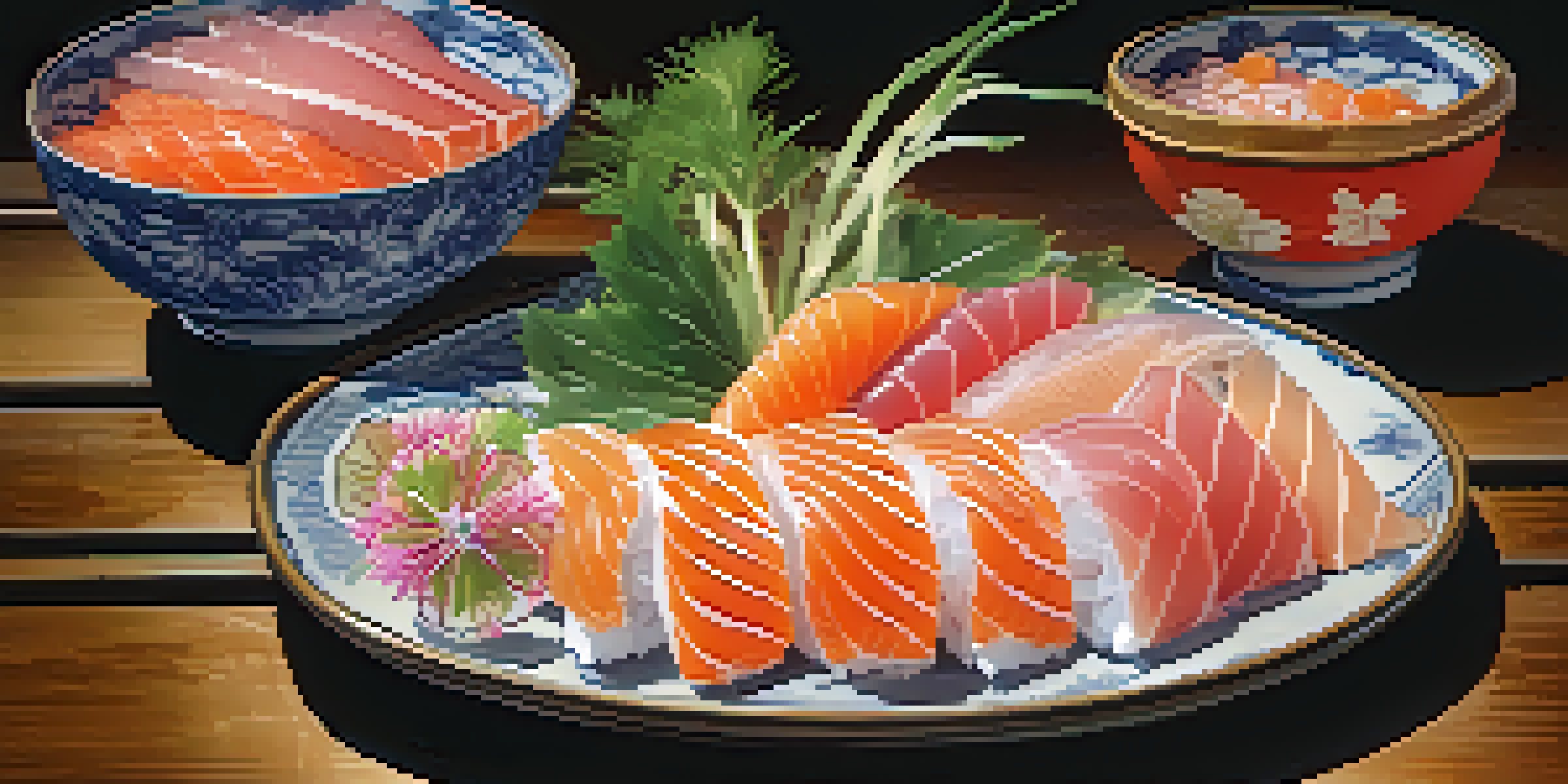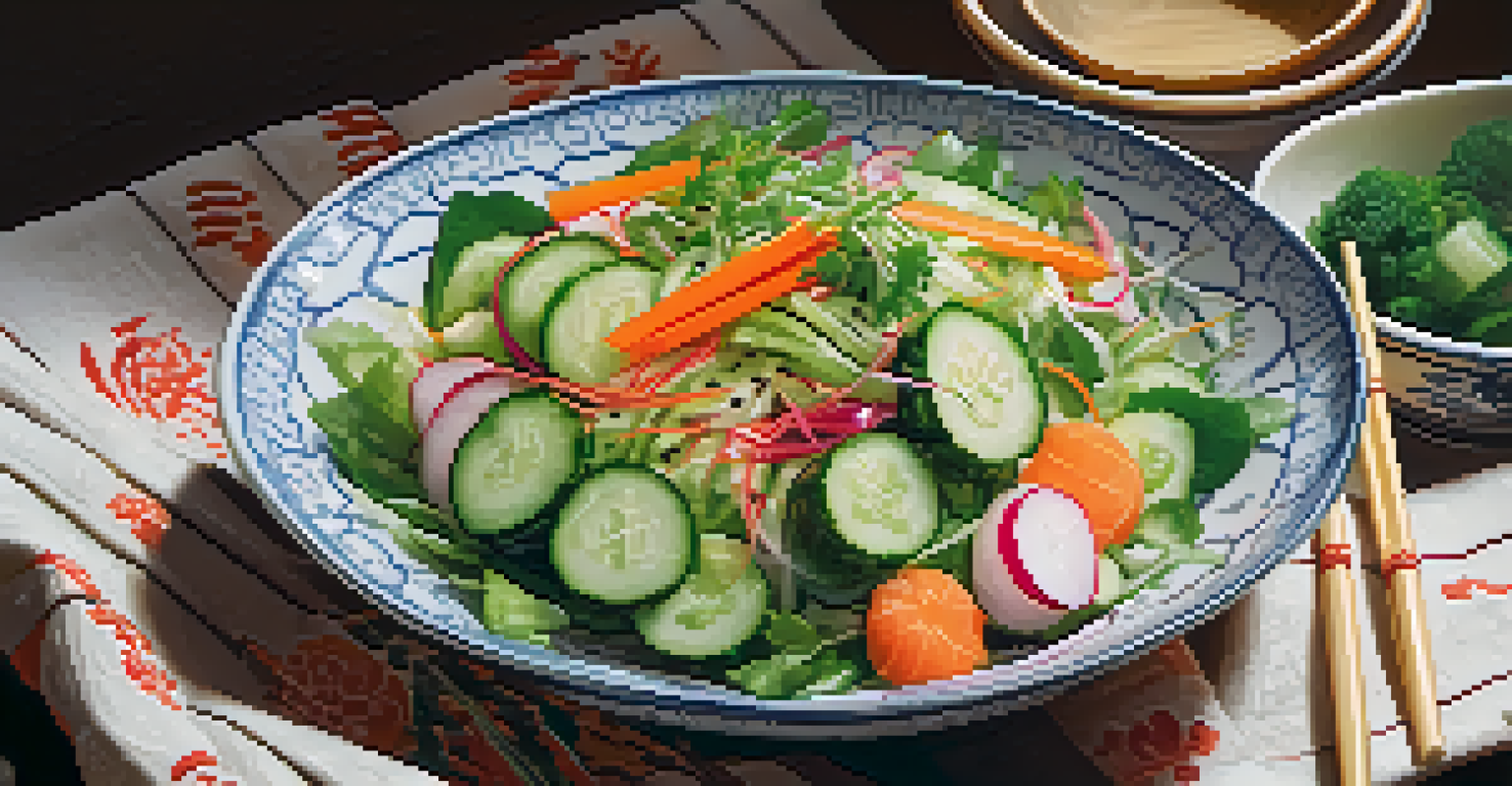Japanese Culinary Practices: The Art of Raw Food Preparation

Understanding the Essence of Japanese Cuisine
Japanese cuisine is more than just food; it's an art form that reflects the culture and philosophy of Japan. At its core, it emphasizes seasonal ingredients, balance, and presentation, with a deep respect for nature. This culinary tradition celebrates simplicity and purity, allowing the natural flavors to shine.
Japanese food is not just about eating; it’s about experiencing everything that goes with it—the taste, the smell, the touch, the presentation.
One key aspect of Japanese cooking is the use of fresh, raw ingredients, which are often highlighted in dishes like sashimi and sushi. These dishes showcase the skill of the chef in selecting and preparing ingredients to enhance their natural taste. The focus on freshness means that seafood and vegetables are often sourced locally, connecting the meal to its environment.
Moreover, the aesthetic presentation is crucial in Japanese dining. Every dish is carefully arranged, as the visual appeal enhances the overall experience. This attention to detail not only pleases the eye but also sets the stage for a deeper appreciation of the flavors.
The Significance of Freshness in Raw Food
Freshness is the cornerstone of raw food preparation in Japanese cuisine. Ingredients must be at their peak to ensure the best taste and texture, which is why many Japanese chefs maintain close relationships with local fishermen and farmers. This dedication to sourcing the highest quality ingredients is what sets Japanese culinary practices apart.

For example, sashimi is a dish that epitomizes this principle. The fish must be ultra-fresh, often prepared moments after being caught. This commitment to freshness not only enhances flavor but also ensures safety, as raw fish requires the highest quality standards.
Freshness Defines Japanese Cuisine
The emphasis on fresh, seasonal ingredients is fundamental in Japanese cuisine, enhancing flavor and ensuring safety.
Additionally, fresh vegetables play a vital role in dishes such as tsukemono (pickled vegetables) and salads. The crispness and vibrant colors of seasonal produce bring an exciting element to the meal, allowing diners to experience the flavors of each season through their food.
The Art of Slicing: Techniques in Raw Food Preparation
In Japanese cuisine, the way food is cut can dramatically influence both its flavor and presentation. Slicing techniques are paramount, particularly when preparing sashimi or vegetables. A skilled chef uses precise cuts to enhance the texture and visual appeal of the dish.
Freshness is not just a quality of food; it is the essence of life itself.
For instance, the 'sukiyaki' cut involves slicing meat and vegetables into thin, uniform pieces for even cooking and easy consumption. Similarly, the 'nagiri' technique in sashimi involves cutting fish against the grain to maximize tenderness. Each technique not only showcases the chef's expertise but also elevates the dining experience.
Furthermore, the tools used in these preparations are equally important. A high-quality knife, like the traditional Japanese yanagiba, is essential for achieving the perfect slice. The care taken in both technique and tools reflects the broader philosophy of Japanese cuisine: reverence for the craft.
Cultural Rituals Surrounding Raw Food
Consuming raw food in Japan often comes with cultural rituals that enhance the dining experience. For example, before enjoying sashimi, it’s customary to express gratitude, known as 'itadakimasu,' which translates to 'I humbly receive.' This practice reinforces a connection to the food and its origins.
Moreover, the presentation of raw dishes is often tied to seasonal themes and celebrations, which are important in Japanese culture. For instance, during cherry blossom season, dishes may incorporate sakura (cherry blossoms) to celebrate the fleeting beauty of spring. These rituals create a deeper appreciation for the meal beyond just taste.
Cultural Rituals Enhance Dining
Cultural practices, such as expressing gratitude before meals, deepen the appreciation for food in Japanese dining experiences.
Additionally, communal dining practices, such as sharing a platter of sashimi, foster a sense of togetherness. These moments of connection over food highlight the importance of community in Japanese culinary traditions, turning each meal into a shared experience.
Health Benefits of Raw Foods in Japanese Cuisine
Raw foods are celebrated in Japanese cuisine not only for their flavor but also for their health benefits. Ingredients like fish, when consumed raw, retain essential nutrients such as omega-3 fatty acids and vitamins that can be diminished through cooking. This focus on health is a significant aspect of the Japanese diet.
Additionally, the consumption of raw vegetables provides a wealth of vitamins and minerals, contributing to overall wellness. Dishes like salads and pickled vegetables are packed with nutrients and are often enjoyed as part of a balanced meal, emphasizing the importance of variety.
Moreover, many raw foods are lower in calories and saturated fats, making them a healthy choice for those looking to maintain a balanced diet. The Japanese approach to eating encourages mindfulness and moderation, promoting a lifestyle that values health and longevity.
Sustainability Practices in Raw Food Preparation
Sustainability is a growing concern in the culinary world, and Japanese cuisine has long embraced practices that respect the environment. The emphasis on seasonal ingredients means that chefs are more likely to choose locally sourced foods, reducing the carbon footprint associated with transportation. This approach not only supports local economies but also ensures the freshest ingredients.
Furthermore, traditional fishing methods in Japan often prioritize sustainability, allowing fish populations to thrive. Practices like 'tako' (octopus) fishing involve careful selection to avoid overfishing, ensuring that seafood remains available for future generations. This respect for marine life is deeply rooted in Japanese culture and culinary practices.
Sustainability in Culinary Practices
Japanese cuisine prioritizes sustainability through local sourcing and zero-waste principles, reflecting a deep respect for the environment.
Additionally, many Japanese chefs are adopting zero-waste principles, utilizing every part of an ingredient. For example, fish bones may be used to make stock, while vegetable scraps can be turned into pickles. This holistic approach to food not only minimizes waste but also maximizes flavor and nutrition.
Exploring Raw Food Dishes: Beyond Sashimi and Sushi
While sashimi and sushi are often the most recognized raw dishes, Japanese cuisine offers a variety of other delightful raw food preparations. For instance, 'namero' is a traditional dish that features minced fish mixed with ingredients like miso and green onions, creating a flavorful and unique experience. This dish highlights the creativity inherent in raw food preparation.
Another example is 'yukhoe,' a Korean-inspired raw beef dish that has gained popularity in Japan. It’s typically seasoned with soy sauce, sesame oil, and served with a raw egg on top. This fusion of flavors showcases how raw ingredients can transcend cultural boundaries while still honoring traditional practices.

Finally, salads featuring raw vegetables, like 'goma-ae' (spinach with sesame dressing), are common in Japanese cuisine. These dishes not only celebrate the freshness of the ingredients but also provide a vibrant contrast to heavier cooked dishes, making them a staple in a balanced diet.